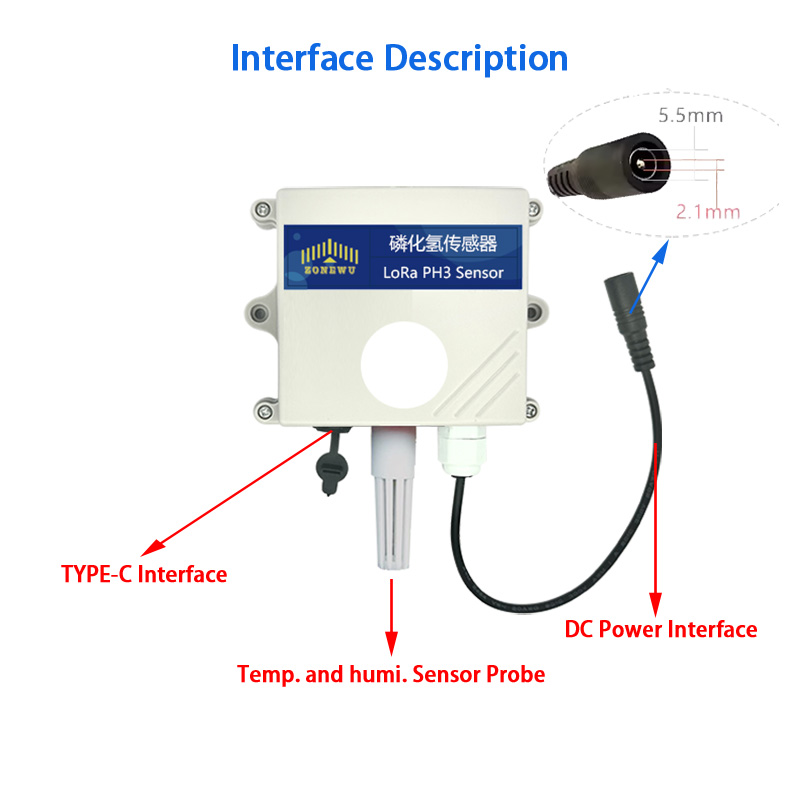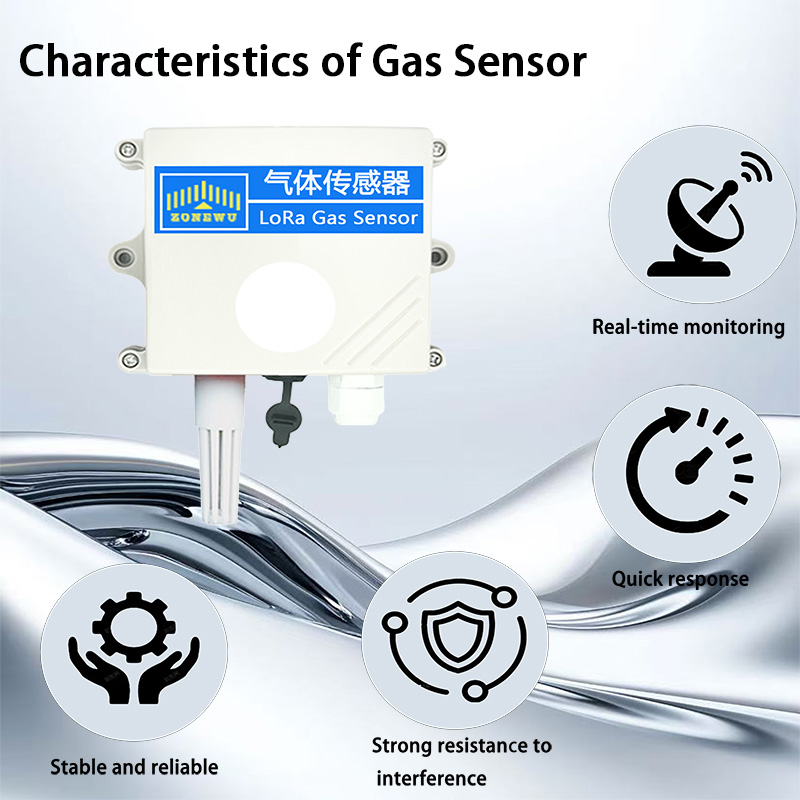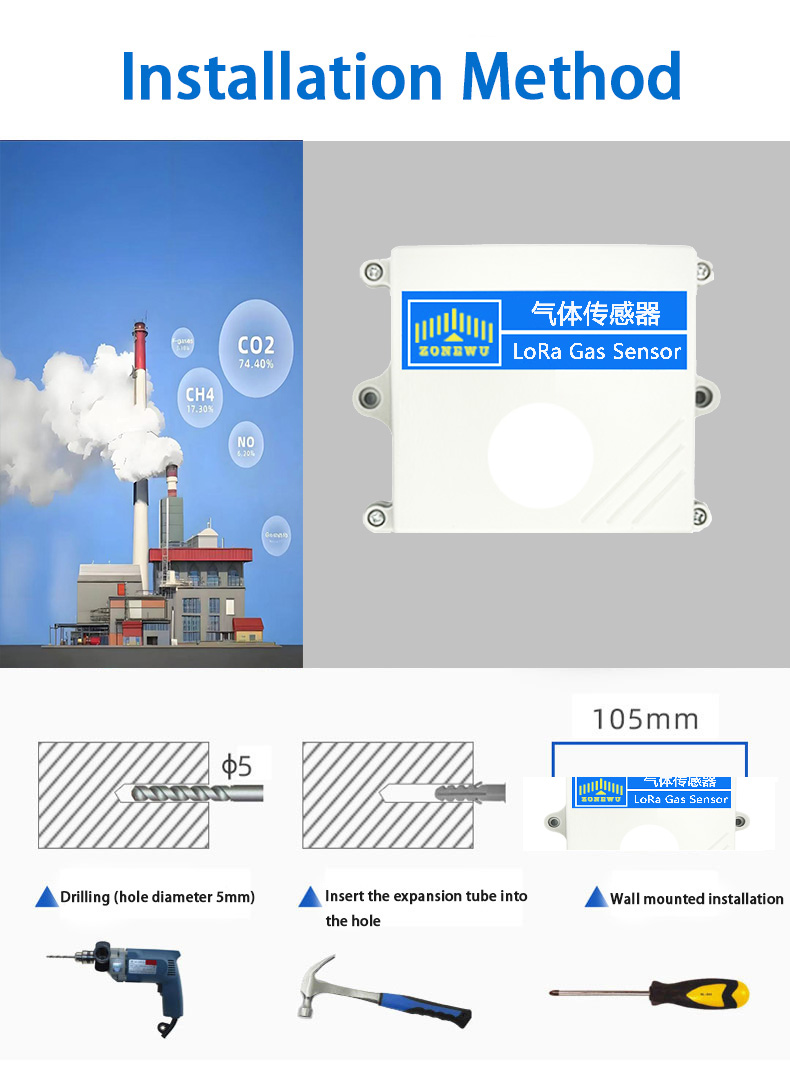xiamen ZONEWU The LoRaWAN Phosphine (PH3) Gas Sensor is a wireless device that can collect, monitor, and transmit data. It is equipped with a phosphine sensor and a temperature and humidity sensor, which can measure the phosphine concentration, temperature, and humidity in the environment in real time. The sensor has a high sensitivity, high resolution, and strong stability, and also supports the standard LoRaWAN protocol, which can transmit data over a long distance.
Produktmodell :
LW318-PH3Stromversorgungsmodus :
Battery or External DCFrequenz :
CN470/IN865/EU868/RU864/US915/AU915/ KR920/AS923-1&2&3&4MAC-Version :
LoRaWAN 1.0.3Modus :
OTAA Class A/CGewicht :
120gEnvironmental LoRaWAN Phosphine (PH3) Sensor
xiamen ZONEWU LoRaWAN Phosphine (PH3) Sensor is a new type of wireless gas sensor based on LoRaTM spread spectrum modulation technology.
xiamen ZoneWu LoRaWAN Gas Sensor PH3 Sensor Features:
This is a wireless gas sensor, which is very powerful. It can collect data such as the concentration, temperature, and humidity of phosphine gas in the environment, and then keep an eye on the data changes. It can also transmit the data, so that we can know the situation at any time.
It uses LoRa spread spectrum modulation technology, which is very powerful and can enable sensors and other devices to communicate over long distances. In addition, the built-in three-electrode electrochemical gas sensor and high-performance microprocessor work in harmony, the former is responsible for accurately detecting the concentration of phosphine gas, and the latter is like a "little head" that quickly processes the data.
There are sensors specifically designed to detect phosphine gas, which can detect the traces of phosphine gas with great sensitivity, as well as temperature and humidity sensors, which can monitor the temperature and humidity of the environment at all times. In addition, it is equipped with a temperature sensor for temperature compensation, so that no matter how the ambient temperature changes, the concentration of phosphine gas can be accurately measured.
It has a high sensitivity; as soon as there is a slight change in the concentration of phosphine gas in the environment, it can detect it immediately. The resolution is high, and the measured data is accurate to a very small value; It has strong stability and is not easily affected by external interference, and can still work normally in complex environments.
A safety value can be set in advance according to the on-site environment. Once the concentration of phosphine gas detected exceeds or falls below this value, it will immediately report to us so that we can take prompt measures.
It has a wide range of applications, such as monitoring the residual phosphine in grain fumigation in the granary; Chemical enterprises monitor whether there is phosphine hydrogen leakage in the production process; These places, such as sewage treatment plants and garbage disposal sites, can also monitor whether phosphine is produced, ensuring everyone's safety and environmental health.
Technical Parameters
| Power Supply | 5~28VDC |
| Weight | 120g |
| Operating Temperature | -20℃~50℃ |
| Measuring Principle | Electrochemistry |
| Lifespan | <2 years |
| Measuring Range |
PH3:(0-1000)ppm
Temp:-40~+80 ℃
Humi:0~99.9 %RH
|
| Frequency |
CN470/IN865/EU868/RU864/US915/AU915/
KR920/AS923-1&2&3&4
|
| Mode | OTAA Class A/C(Default: Class C) |
| Reporting cycle |
External power supply:5min(Default reporting cycle)
Report after preheating for 3 minutes when powered on
|
| Communication Protocol | LoRaWAN,LoRa TDMA Networking |
|
Equipment information
(Reference)
|
AppEUI:0000000000000001
DevEUI:aaaa202404150001
AppKey:00001111222233334444555566667777
MAC Version:LoRaWAN 1.0.3
|
Product Applications
1. High sensitivity and fast response: This sensor can detect extremely small amounts of phosphine gas and quickly accurately calculate the concentration, and immediately alarm when an anomaly is detected. Quick response and high sensitivity can reduce safety risks and save time for emergency handling.
2. Strong stability: No matter whether the temperature is high or low, the humidity changes, or there are other gas interference around, this sensor can work steadily, without any trouble for a long time, and the data is always reliable.
3. High selectivity: It can accurately distinguish hydrogen phosphide and other similar gases, and will not make mistakes (such as mistaking other gases for hydrogen phosphide), greatly reducing false alarms and missed alarms, and making the monitoring results more accurate and reassuring.
4. It has strong anti-interference ability: Even in a complex industrial environment with various kinds of interference, it can quickly grasp the subtle changes of phosphine and give reliable data to help us carry out environmental monitoring.
Detailed Images



Common knowledge of PH3
What is phosphine (PH₃)?What are the characteristics
Phosphine is a colorless, highly toxic gas with a fishy or garlic smell (the smell may be numb and undetectable at high concentrations), flammable at room temperature (explosive when mixed with air at 1.7% to 26%).It is an important chemical intermediate (used in semiconductor doping and pesticide synthesis) and a fumigant for grain storage (such as the hydrolysis of aluminum phosphide tablets to produce PH₃ insecticide), but it has serious toxicity to the human nervous system and respiratory system, and long-term low-concentration exposure may cause liver and kidney damage.
What is the safe concentration limit of phosphine in the air
Occupational exposure limit value (PC-TWA, 8 hours):
Dangerous concentration:
What are the main sources of phosphine? Why is it easily overlooked
Industrial and agricultural scenarios:
Concealability:
What interference factors should be paid attention to when detecting the concentration of phosphine
Other gas interference:
Temperature and humidity:
Differences in sensor types:
Application Scenarios

Industrial production
Waste gas emission monitoring: Conduct real-time monitoring of industrial waste gas emissions to ensure that waste gases meet emission standards and reduce pollution to the environment.

Environmental inspection
Air quality monitoring helps people understand air quality and protect the environment and health by detecting harmful gases such as sulfur dioxide.

Safety protection
In coal mines and tunnels, gas sensors detect toxic and harmful gases such as methane and warn against accidents.
A:Yes,we can provide you with OEM services and design housings and logos.
3.DO you offer free samples?
A:Sorry,we don't offer free samples. After ordering in bulk, we will deduct the sample fee from the second order.
Why Choose ZONEWU